Karol Bagh
Karol Bagh ( pronounced [qəroːl baːɣ]) is a neighbourhood in Central Delhi district, Delhi, India. It is a mixed residential-cum-commercial neighbourhood known for its shopping streets, like the Ghaffar Market and Ajmal Khan Road.
Karol Bagh | |
|---|---|
Neighbourhood of Delhi | |
| Nickname(s): K.B., Q.B. | |
 Karol Bagh Location in Delhi, India | |
| Coordinates: 28.6629°N 77.210°E | |
| Country | India |
| State | Delhi |
| District | Central Delhi |
| Population | |
| • Total | 505,242 |
| Time zone | GMT + 0530 |
| PIN Code | 110005 |
| Lok Sabha constituency | New Delhi (formerly Karol Bagh) |
| Vidhan Sabha constituency | Karol Bagh |
| Civic agency | MCD |
| Distance From Airport = 18 KM Distance From Railway = 3 KM | |
It was also home to the Karol Bagh Lok Sabha constituency till it was abolished in 2008, now it is a Legislative Assembly of Delhi segment of the New Delhi constituency.
Noted residential places in Karol Bagh are W.E.A, Beadon Pura, Reghar Pura, Dev Nagar, and Bapa Nagar. These are residential colonies with mix of Commercial activities. Some Wholesale markets are located in the area namely. Tank Road Garment Market, Hardhyan Singh Road Leather market etc.
A wholesale garment market known as Tank Road Market came into existence with few shopkeepers at the end of the 1980s. It offers multiple stores for ethnic women wear i.e. suits, sarees, lehengas etc.
History

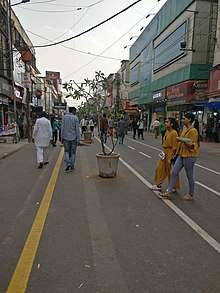
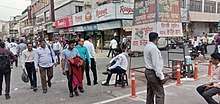

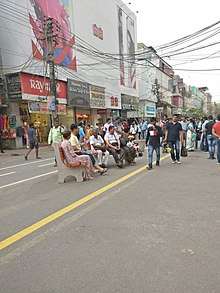


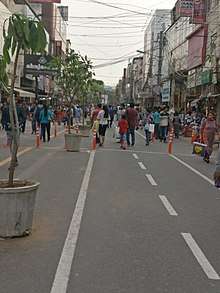
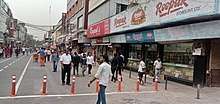
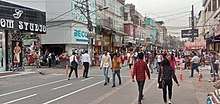
In the 1920s, residents of villages like Madhoganj, Jaisingh Pura, and Raja ka Bazaar evacuated to build Connaught Place and nearby areas, were relocated in Karol Bagh to the West, then a rocky area populated by trees and wild bushes.[1]
The area was primarily residential with a large Muslim population until the exodus of many Muslims to Pakistan and an influx of refugees from West Punjab and Sindh after partition in 1947,[2] many of whom were traders. There remains a sizeable Marathi-speaking population. There is also a Tamil-speaking population.[3] Karol Bagh is also home to a large Bengali community, and hosts one of the oldest Durga Puja in the city, Their numbers have increased many folds since late 1990s, most of which are employed in jewellery manufacturing.
Several incidents were reported at Karol Bagh during the 1984 anti-Sikh riots, including burning of shops.[4] Karol Bagh was the target of a terrorist attack in October 2008 when there was a bomb blast in Ghaffar Market.[5]
Education
The historic Ayurvedic and Unani Tibbia College was inaugurated here by Mahatma Gandhi in 1921,[6] and Sri Guru Nanak Dev Khalsa College, also of Delhi University is situated here.
Markets
The area is now considered where the affluent people of West and Central Delhi go to shops, with a busy shopping streets including Ajmal Khan Road, Arya Samaj Road, and the Ghaffar Market, named after freedom fighter Khan Abdul Ghaffar Khan, Tip Top Market (Established by Sh Vikas Lal Jain in the year 2000). In the recent years, many western businesses have established themselves in this area. Pizza Hut, TGIF, Reebok, Skechers, Puma and Lacoste have all established successful businesses in Karol Bagh.. Many eateries also exist such as Pind Balluchi etc.
Food
Karol Bagh is renowned for its eateries that offer lip smacking food at a very reasonable price. The famous Roshan Di Kulfi is situated in the heart of Karol Bagh market and is often pack with foodies who relish the famous Kulfi and Chole Bhature. Roopak stores is a one stop destination for all sorts of spices and has a Pani Puri (Gol Gappa) shop right outside the store which offers possibly the best Pani Puri is Delhi. Standard Sweet shop is renowned for its Barfi and Aloo Puri which is a must have for the residents nearby on Sundays. Bikanerwala is packed with people buying sweets during festive season. There is also Raffel's which offer bakery items and has an ice cream counter facing the main walkway of the market.
Transport

Nearest railway stations are Delhi Sarai Rohilla and Delhi Kishanganj, both about a kilometer from Central Karol Bagh. Karol Bagh is situated at a distance of 20 – 22 km. from the Indira Gandhi International Airport, and 4.1 km. from New Delhi Railway Station.[7] It is also serviced by the Karol Bagh station, located on the Blue Line of the Delhi Metro. One can see famous giant statue of lord Hanuman between Jhandewalan and Karol Bagh metro station. also it's Education hub of IAS Academy in New Delhi. The Pin Code of Karol Bagh [8] is 110005.
In popular culture
12/24 Karol Bagh (2009–2010), a TV series shown on Zee TV, was set in Karol Bagh and shot and produced in Delhi. Its subsequent success started the trend for many TV serials being set in Delhi.[9] Zoya Singh Solanki the central character in the romantic comedy novel by Anuja Chauhan, The Zoya Factor (2008) lives in Karol Bagh, who ends up becoming the lucky mascot for the Indian cricket team in the novel.[10]
References
- "A tale of two cities". Hindustan Times. 1 September 2011. Archived from the original on 2 July 2015.
- Singh, Andrea (1976). Neighbourhood and Social Networks In Urban India. Marwah Publications. p. 67.
- Ganesh, Narayani (15 September 2002). "Ubiquitous 'Madrasi' in Delhi". Times of India. Retrieved 14 September 2008.
- Das, Veena (2007). Life and words: violence and the descent into the ordinary. University of California Press. p. 137. ISBN 0-520-24745-0.
- "Karol Bagh's markets live in constant fear of a terrorist attack". Hindustan Times. 17 October 2015.
- Sah, Ram Swarth (25 December 2003). "Old medicine, new learners". The Hindu. Retrieved 15 December 2007.
- http://www.roaddistance.in/delhi/new-delhi-railway-station-bhavbhuti-marg-to-karol-bagh-distance/by-road/
- "Details of Post Office & Pin Code of Karol Bagh, Central Delhi, Delhi". Pincode. Retrieved 11 May 2018.
- "Delhi's driving TV content". The Times of India. 17 December 2010.
- "Books: The Zoya Factor: Chick-lit cricket, Interview". CNN-IBN. 21 October 2008.